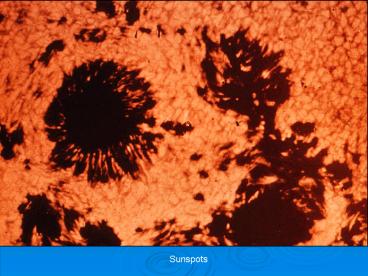Sunspots PowerPoint PPT Presentation
1 / 11
Title: Sunspots
1
Sunspots
2
X-ray solar image
3
(No Transcript)
4
Solar Flair
5
Solar Corona
6
A bright solar flare is captured by the EIT 195Å
instrument on 1998 May 2. A solar flare (a
sudden, rapid, and intense variation in
brightness) occurs when magnetic energy that has
built up in the solar atmosphere is suddenly
released, launching material outward at millions
of km per hour. The Suns magnetic fields tend to
restrain each other and force the buildup of
tremendous energy, like twisting rubber bands, so
much that they eventually break. At some point,
the magnetic lines of force merge and cancel in a
process known as magnetic reconnection, causing
plasma to forcefully escape from the Sun.
7
A comparison of two EIT images almost two years
apart illustrates how the level of solar activity
has increased significantly. The Sun attains its
expected sunspot maximum in the year 2000. These
images are captured using Fe IX-X 171 Å emission
showing the solar corona at a temperature of
about 1.3 million K. Many more sunspots, solar
flares, and coronal mass ejections occur during
the solar maximum. The numerous active regions
and the number/size of magnetic loops in the
recent image shows the increase
8
This composite image combines EIT images from
three wavelengths (171Å, 195Å and 284Å) into one
that reveals solar features unique to each
wavelength. Since the EIT images come to us from
the spacecraft in black and white, they are color
coded for easy identification. For this image,
the nearly simultaneous images from May 1998 were
each given a color code (red, yellow and blue)
and merged into one.
9
A rapidly expanding "solar quake" on the Suns
surface depicted here by the Michelson Doppler
Imager (MDI). It immediately followed a solar
flare on 1996 July 6 and spread out more than
100,000 km at the solar surface. Scientists have
shown that solar flares produce seismic waves,
and gigantic seismic quakes, in the Sun's
interior. They have tracked these seismic waves
and found that "sun-quakes" closely resemble
earthquakes on our planet.
10
A LASCO C2 "running difference" image showing a
"halo" CME blast beginning its journey towards
Earth. With the LASCO C2 instrument providing a
perspective of about six solar, the Sun is seen
hurtling particles into space during a CME on 7
April 1997. The image compares one image to the
preceding one and highlights the areas of change
between the two. This gives a clearer
representation of the dynamics of this "halo
event," so called because the circular area of
the edges of the blast seem to form a kind of
halo around the Sun.
11
Sites http//umbra.nascom.nasa.gov/eit/eit_movie
s.html (has nice movies) http//sohowww.nascom.
nasa.gov/

